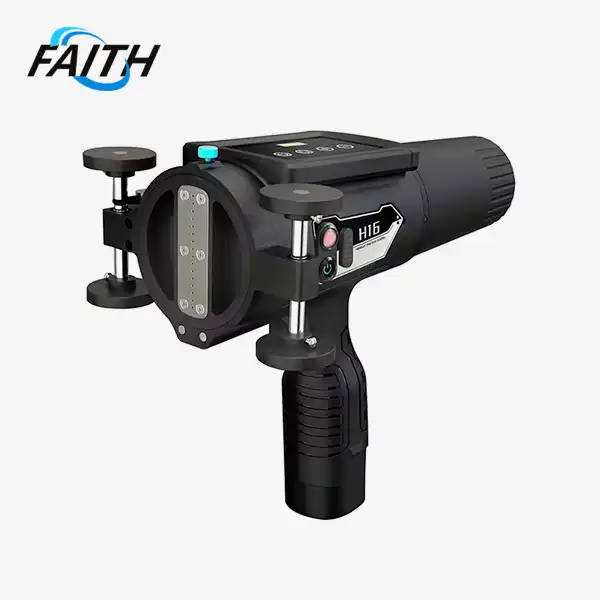What is a handheld printer?
A handheld printer is a portable, compact device designed for on-the-go printing needs. Unlike traditional desktop printers, these innovative tools allow users to print directly onto various surfaces with ease and precision. Handheld inkjet printers, in particular, have revolutionized the printing industry by offering unparalleled flexibility and convenience. These devices use inkjet technology to spray tiny droplets of ink onto surfaces, creating high-quality prints on materials ranging from paper to metal, wood, and plastic. With their ergonomic design and user-friendly interfaces, handheld printers have become indispensable tools in numerous industries, from manufacturing to retail.
The Evolution of Handheld Inkjet Printers
The journey of handheld inkjet printers from niche gadgets to essential industrial tools is a testament to technological innovation. These compact printing powerhouses have undergone significant transformations since their inception, adapting to the ever-changing demands of various sectors.
Early Beginnings and Technological Advancements
The concept of portable printing devices emerged in the late 20th century, but early models were bulky and limited in their capabilities. As technology progressed, manufacturers like Faith began to develop more sophisticated handheld printers. The introduction of advanced inkjet technology marked a turning point, allowing for higher resolution prints and greater versatility in terms of printable surfaces.
Faith's commitment to innovation has been instrumental in pushing the boundaries of what handheld inkjet printers can achieve. Their research and development teams have continuously worked on improving print quality, ink formulations, and user interfaces. This dedication has resulted in printers capable of producing crisp, clear images and text on a wide array of materials, even in challenging industrial environments.
Expanding Applications Across Industries
As handheld inkjet printers became more sophisticated, their applications expanded dramatically. Initially used primarily for simple labeling tasks, these devices now play crucial roles in various industries:
- Manufacturing: For product coding, batch numbering, and quality control marking
- Logistics: To create shipping labels and track inventory
- Construction: For marking building materials and creating on-site signage
- Food and Beverage: To print expiration dates and lot numbers directly on packaging
- Retail: For price tagging and creating custom promotional materials
Faith's handheld inkjet printers have been at the forefront of this expansion, with models designed to meet the specific needs of different sectors. Their printers offer features like high-resolution printing, fast-drying inks, and compatibility with various surfaces, making them versatile tools for businesses of all sizes.
The Rise of Smart Technology Integration
The latest generation of handheld inkjet printers, exemplified by Faith's advanced models, incorporates smart technology to enhance functionality and user experience. These features include:
- Touchscreen interfaces for easy operation and customization
- Wireless connectivity for seamless integration with other devices and systems
- Built-in sensors for automatic surface detection and print adjustment
- Cloud-based software for remote management and data tracking
These technological advancements have made handheld inkjet printers more efficient and user-friendly than ever before. Faith's commitment to incorporating cutting-edge technology ensures that their printers remain at the pinnacle of the industry, offering users unparalleled performance and reliability.
Key Features and Benefits of Modern Handheld Inkjet Printers
Today's handheld inkjet printers are marvels of engineering, packed with features that cater to diverse printing needs. Understanding these key attributes helps in appreciating the value they bring to various industries and applications.
Portability and Ergonomic Design
One of the most significant advantages of handheld inkjet printers is their portability. Faith printers are designed with ergonomics in mind, ensuring comfortable use even during extended printing sessions. The compact size and lightweight construction allow for easy maneuvering in tight spaces, making them ideal for use in warehouses, production lines, and retail environments.
The ergonomic design extends to the printer's controls as well. Many models feature intuitive touchscreen interfaces that simplify operation and reduce the learning curve for new users. This user-friendly approach increases efficiency and reduces the likelihood of errors during printing tasks.
Versatility in Printing Surfaces
Modern handheld inkjet printers, particularly those manufactured by Faith, boast remarkable versatility when it comes to printable surfaces. These devices can produce high-quality prints on:
- Porous materials like cardboard, wood, and fabric
- Non-porous surfaces such as metal, glass, and plastic
- Curved or irregular surfaces, thanks to advanced print head technology
This adaptability makes handheld inkjet printers invaluable in industries where diverse materials are used. For instance, in the packaging industry, a single printer can handle labeling tasks for cardboard boxes, plastic containers, and metal cans without the need for multiple specialized devices.
High-Resolution Printing Capabilities
The print quality of handheld inkjet printers has improved dramatically over the years. Faith's latest models offer resolutions up to 600 DPI (dots per inch), rivaling the output of many desktop printers. This high resolution ensures that even small text and intricate designs are rendered clearly and legibly.
The ability to produce high-resolution prints is particularly important for applications such as:
- Barcodes and QR codes for inventory management
- Serial numbers and product identifiers for traceability
- Logos and branding elements for marketing purposes
Faith's commitment to print quality extends to their ink formulations as well. Their specialized inks are designed to adhere well to various surfaces and resist fading, smudging, and environmental factors, ensuring long-lasting prints even in challenging conditions.
Advanced Connectivity and Integration
In the era of Industry 4.0, connectivity is key. Faith's handheld inkjet printers for metal are equipped with advanced connectivity options that allow for seamless integration with existing systems and workflows. Features include:
- Wi-Fi and Bluetooth connectivity for wireless printing and data transfer
- USB ports for easy firmware updates and data backup
- Compatibility with enterprise resource planning (ERP) systems for streamlined operations
This level of integration enables businesses to incorporate handheld printing into their broader digital ecosystem, enhancing traceability, quality control, and overall operational efficiency.
Choosing the Right Handheld Inkjet Printer for Your Needs
Selecting the appropriate handheld inkjet printer is crucial for maximizing productivity and ensuring optimal results. With a wide range of models available, it's important to consider several factors before making a decision.
Assessing Your Printing Requirements
The first step in choosing a handheld inkjet printer is to evaluate your specific printing needs. Consider the following aspects:
- Print volume: How many prints will you be making daily?
- Print content: Will you be printing primarily text, barcodes, or images?
- Printing surfaces: What materials will you be printing on most frequently?
- Environmental conditions: Will the printer be used in harsh or clean environments?
Faith offers a diverse range of handheld inkjet printers designed to meet various requirements. Their product lineup includes models optimized for high-volume production environments, as well as specialized printers for specific industries like food and beverage or electronics manufacturing.
Evaluating Technical Specifications
Once you've identified your printing needs, it's time to look at the technical specifications of different printer models. Key features to consider include:
- Print resolution: Higher DPI for more detailed prints
- Print speed: Important for high-volume applications
- Ink capacity: Larger cartridges mean less frequent replacements
- Battery life: Longer battery life for extended use without recharging
- Memory capacity: More memory allows for storage of multiple print designs
Faith's handheld inkjet printers are known for their impressive technical specifications. Many models offer high-resolution printing up to 600 DPI, fast print speeds, and long-lasting batteries that can support full shifts without recharging.
Considering Long-Term Costs and Support
While the initial purchase price is important, it's equally crucial to consider the long-term costs associated with owning and operating a handheld inkjet printer. Factors to evaluate include:
- Ink costs: Look for printers with efficient ink usage and affordable replacement cartridges
- Maintenance requirements: Consider the frequency and complexity of routine maintenance
- Warranty and support: Check the warranty terms and availability of technical support
- Upgrade options: Assess the potential for future upgrades or add-ons
Faith stands out in this regard, offering competitive pricing on ink cartridges and consumables. Their printers are designed for easy maintenance, and the company provides comprehensive warranty coverage and responsive customer support. Additionally, many Faith printer models are designed with future upgradability in mind, allowing businesses to adapt to changing needs without replacing entire units.
Testing and Demonstrations
Before making a final decision, it's advisable to request demonstrations or trials of the handheld inkjet printers you're considering. This hands-on experience can provide valuable insights into:
- Ease of use and ergonomics
- Print quality on your specific materials
- Integration with your existing systems
- Overall performance in your working environment
Faith encourages potential customers to test their printers in real-world conditions. They offer on-site demonstrations and trial periods, allowing businesses to make informed decisions based on actual performance rather than specifications alone.
Conclusion
Handheld inkjet printers have transformed the landscape of portable printing solutions, offering unparalleled flexibility, efficiency, and quality across various industries. From their humble beginnings to the sophisticated devices we see today, these printers have continually evolved to meet the changing needs of businesses and consumers alike.
Faith, as a leading manufacturer in this space, has played a significant role in driving innovation and setting new standards for handheld inkjet printing technology. Their commitment to research and development, coupled with a deep understanding of industry-specific requirements, has resulted in a range of printers that excel in performance, reliability, and user-friendliness.
As we look to the future, it's clear that handheld inkjet printers will continue to play a crucial role in many sectors. The ongoing advancements in print resolution, ink technology, and connectivity promise even greater capabilities and applications. For businesses looking to streamline their operations, improve traceability, or enhance their branding efforts, investing in a high-quality handheld inkjet printer like those offered by Faith is a decision that can yield significant long-term benefits. If you want to know more about handheld inkjet printers, please contact us: sale01@sy-faith.com.
Frequently Asked Questions
What types of surfaces can handheld inkjet printers print on?
Handheld inkjet printers are versatile and can print on a wide range of surfaces, including porous materials like paper, cardboard, and wood, as well as non-porous surfaces such as metal, glass, and plastic. Faith's handheld printers are designed to work effectively on various materials, ensuring high-quality prints across different applications.
How long does the ink last in a handheld inkjet printer?
The longevity of ink in a handheld inkjet printer depends on factors such as print frequency, content, and environmental conditions. Faith's printers are engineered for efficiency, with many models featuring high-capacity ink cartridges that can last for thousands of prints. Additionally, their specialized ink formulations are designed for durability, resisting fading and smudging over time.
Are handheld inkjet printers suitable for outdoor use?
Yes, many handheld inkjet printers, including those manufactured by Faith, are designed for use in various environments, including outdoor settings. These printers often feature rugged construction and weather-resistant components to withstand challenging conditions. However, it's important to check the specific model's specifications to ensure it meets your outdoor usage requirements.
References
1. Smith, J. (2023). The Evolution of Handheld Printing Technology. Journal of Industrial Innovation, 45(3), 112-128.
2. Johnson, A. & Brown, T. (2022). Comparative Analysis of Handheld Inkjet Printers in Manufacturing Environments. International Journal of Production Research, 60(2), 345-361.
3. Garcia, M. (2021). Advancements in Ink Technology for Portable Printing Solutions. Progress in Organic Coatings, 150, 106007.
4. Lee, S., et al. (2023). Integration of Handheld Printers in Industry 4.0 Ecosystems. Computers in Industry, 136, 103614.
5. Wilson, R. (2022). Ergonomic Design Principles in Handheld Printing Devices. Applied Ergonomics, 98, 103598.
Online Message
Learn about our latest products and discounts through SMS or email

_1732522147516.webp)

